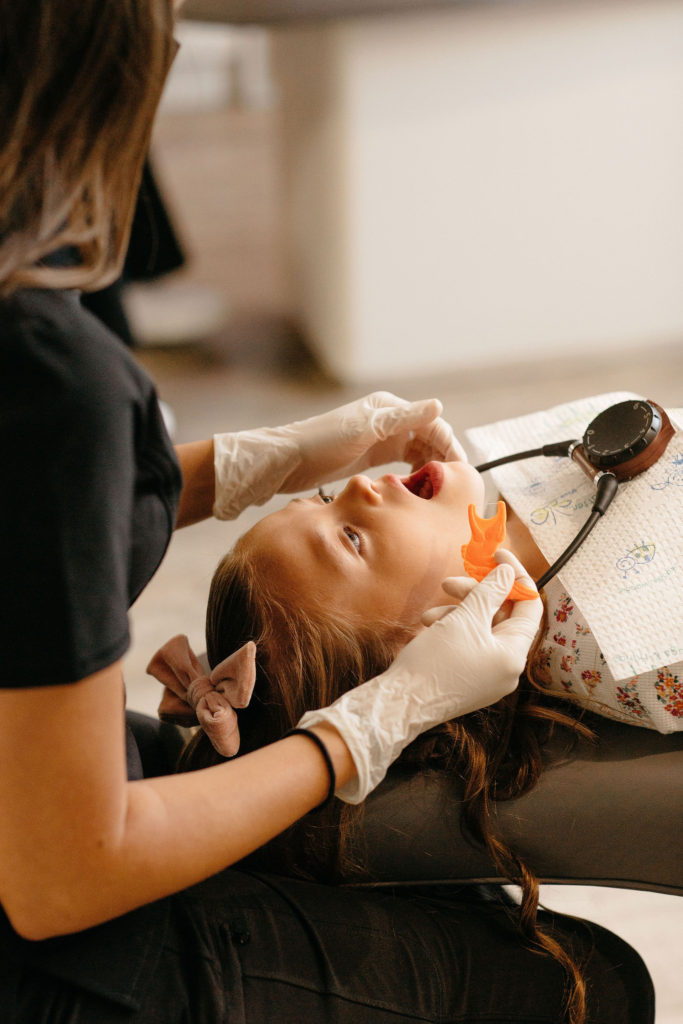Crowns
What is a Dental Crown?
A dental crown is a cap that has been formed into the shape of the tooth and placed over the tooth to prevent any further decay or damage to it. Tooth crown materials are mixed, molded, and hardened in a lab. The crowns are then set onto the tooth and set to cover it, sealing the tooth off from the rest of the teeth.

Are there Advantages to doing a Porcelain Crown?
The color of a porcelain crown is a major advantage, as it can be tinted to match the surrounding teeth. However, keep in mind that porcelain crowns won’t respond to whitening products, so it’s important to be cautious with teeth whitening. While porcelain crowns may not be as durable as stainless steel ones, they are still strong and reliable. With proper care and good dental hygiene, a porcelain crown can last for a long time.
What Happens in a Dental Crown Procedure?
Typically, the procedure for a dental crown takes two visits. For the first visit, we must prepare the tooth. We may do X-rays as part of the preparation. We also may do an impression of your child’s mouth beforehand for a baseline. Next, we will file the tooth, removing the damage and part of the outer layer of the tooth and reshape it to receive a crown. We then make another impression of your child’s mouth. This impression is for the crown. We form a temporary crown or cap for your child’s tooth, and that completes the first visit. We send the impressions of your child’s tooth and jaw to a special lab that is responsible for creating the dental crown.
Your second visit will be scheduled for when the dental crown is completed. Your child’s temporary crown will be removed, and we will thoroughly clean and prepare the tooth. We will check the fit of the crown to the tooth before adhering it. The dental crown will be placed on the tooth and sealed.
Generally, while they have the temporary resin crown, we advise our patients to avoid sticky, sugary, chewy candies, gum, or hard foods. Minimizing the chewing on the side of the mouth with the temporary crown is also a good idea. The temporary crown is-after all-only temporary and we want that temporary crown to last until the permanent crown is ready.
Is the Procedure for a Dental Crown Painful?
Before starting the procedure, we apply local anesthesia to ensure your child feels no pain during the treatment. However, we understand that due to age, development, or anxiety, local anesthesia alone might not be enough for some children.
We will talk with you and your child beforehand to assess their emotional needs and determine the best approach for a calm, comfortable experience. We offer four sedation options in-office and are happy to discuss them and answer any questions. For more information about our sedation options, visit our dedicated page or ask us during your visit!
What is the Lifespan of a Dental Crown?
The lifespan of a dental crown varies from five to 15 years or even longer. There are a lot of factors that contribute to the lifespan of a dental crown. Proper dental hygiene, routine dentist visits for checkups and professional cleanings are all things within your control that you can do to ensure your child’s dental crown lasts a long time. Other factors that can shorten the lifespan of a dental crown include teeth grinding, gum disease, fingernail biting, jaw clenching, or using teeth to open bottles or packaging.
We want the best for your child and their dental well-being. The importance of preventative care cannot be overstated. We encourage you to develop healthy dental hygiene routines in your home, and be mindful of foods, snacks, sodas, and sugary juices in your child’s diet.
Dental Crowns for Kids
In some cases, a tooth may be too decayed or damaged for a composite filling or pulpotomy to provide sufficient repair. When that happens, a dental crown may be the best treatment option. In this section, we’ll explain everything you need to know about the different types of crowns, the materials used, and what to expect during the process.
What are my Child’s Options for a Dental Crown?
Here at North Davis Pediatric Dentistry, we offer two different types of crowns and will use whichever is more appropriate to serve your child’s needs. We offer both stainless steel crowns, and porcelain crowns.
When is a Stainless Steel Crown Recommended?
We generally recommend stainless steel crowns when the involved tooth is not immediately visible, a molar for example.
Why
Stainless steel crowns have the advantage of being sturdier than their porcelain counterparts. They can withstand more force from biting and chewing and generally have a longer lifespan. Additionally, when stainless steel crowns are used, more of the involved tooth’s natural structure can be maintained. Because of their durability, stainless steel crowns rarely chip or crack.
If a Stainless Steel Crown has so many Advantages, Why should I opt for a Porcelain Crown for my child?
The main draw back to a stainless steel crown is its metallic appearance. Because it is a metal based dental product, its color reflects that. Different types of crowns for teeth have been developed to lend a more aesthetically pleasing result. Most people and children prefer white tooth crowns for any tooth that is located in the front of the mouth.

How Should my Child Take Care of their Teeth after having a Dental Crown?
After your child gets a dental crown, we recommend avoiding sticky, chewy candies for a few days. Other than that, their daily routine can go back to normal. While a dental crown protects the tooth, it doesn’t protect the gums, so maintaining good dental hygiene is crucial for healthy gums.
Be sure to keep up with brushing twice a day with fluoride toothpaste for two minutes and flossing at least once a day to maintain your child’s overall dental health. This should continue even after receiving a dental crown.
Dentists on Our Team
Years Combined Experience
In-house Sedations
Patients
Counties Served
Staff members
Don't Wait Any Longer!
Schedule Your Child's Appointment Today








